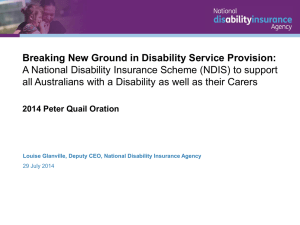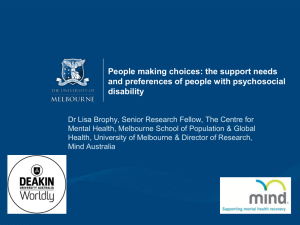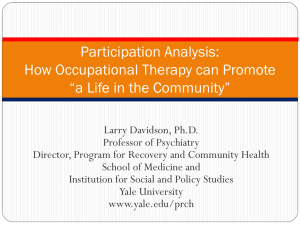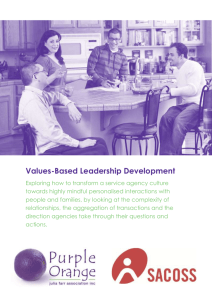Unpacking choice and control: Issues around
advertisement
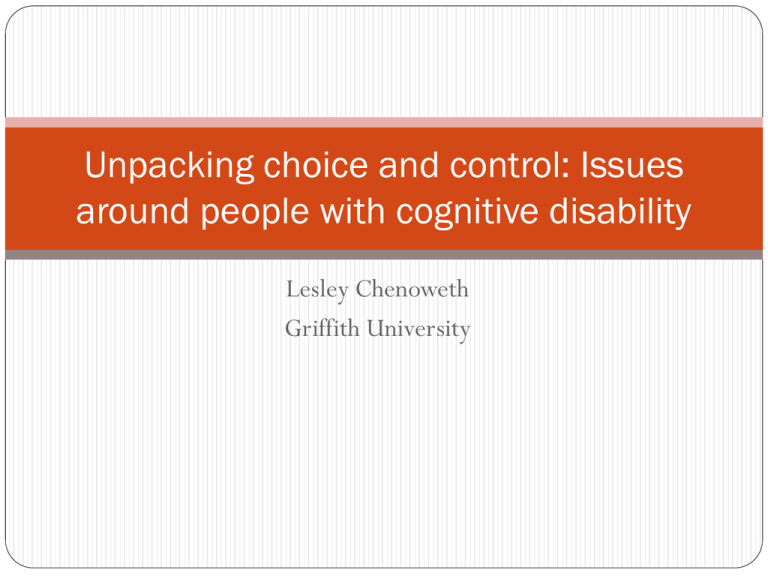
Unpacking choice and control: Issues around people with cognitive disability Lesley Chenoweth Griffith University Overview Background Legislative base Definitions - choice and control What does the evidence tell us? How can we maximise choice and control for people with cognitive disability Choice and control continuum Background The NDIS founded strongly on principles of choice and control. NDIS reorients funding dollars AND the supports available so that people with disabilities will have choice and control over: their goals planning & delivery of supports Legislative base Everyday life control and choice consistent with the United Nations Convention on the Rights of Persons with Disabilities. built on a principle of ‘equal opportunity’ according to which people should not have less or more opportunity than others on the basis of disability. The National Disability Insurance Scheme Bill stated: 4 (14) Innovation, quality, continuous improvement, contemporary best practice and effectiveness in the provision of supports to people with disability are to be promoted. Legislative base The National Disability Insurance Scheme Bill Objects includes: (e) enable people with disability to exercise choice and control in the pursuit of their goals and the planning and delivery of their supports And Principles (4) People with disability should be supported to exercise choice, including in relation to taking reasonable risks, in the pursuit of their goals and the planning and delivery of their supports. Framework for Choice & Control Internationally and in Australia, research has shown that reforms to disability and human services which embed greater choice and control for service users have been found to result in better life outcomes for people with disability, as well as more efficient and effective service outcomes (KPMG for NSW Ageing Disability and Home Care, 2012, p9). Definitions/ meanings Choice – what one must do when faced with two or more options. Highly valued concept but also very broad. Society values choice – linked to consumerism? Control – shifting power to the person/ family Related to self determination Linked to choice The right to make choices is proposed as the cornerstone of selfdetermination. (Green, 2010) Choice theories William Glasser’s choice theory We choose everything we do, whether we choose to be happy or choose to let others control our life and make us miserable. All we can do is get or give information from others. We are in control of our own selves and that information from others cannot make us do anything. All of our behaviors have a purpose, whether they are responsible or not. We choose to behave to improve our quality world and help to meet our 5 basic needs. Survival Power Love & belonging Fun Freedom Choice theories Rational choice theory – from microecnomics. Economic principle that assumes that individuals always make prudent and logical decisions that provide them with the greatest benefit or satisfaction and that are in their highest self-interest. Most mainstream economic assumptions and theories are based on rational choice theory. Public choice theory - the economic theory relating to how much choice the public has in the economic decisions taken by a government. The public does not have a single preference, but many different preferences which can not all be reflected in a government’s economic policy. Choice theories Social choice theory - study of collective decision processes and procedures. Not a single theory - cluster of models and results concerning the aggregation of individual inputs (e.g., votes, preferences, judgments, welfare) into collective outputs (e.g., collective decisions, preferences, judgments, welfare). Central questions: How can a group of individuals choose a winning outcome from a given set of options? What are the properties of different voting systems? When is a voting system democratic? How can a collective (e.g., electorate, court, committee) arrive at coherent collective preferences or judgments on some issues, on the basis of its members' individual preferences or judgments? How can we rank different social alternatives in an order of social welfare? Research findings 1 Ticha et al (2012) 8,892 adults with ID 19 states USA Everyday choices – e.g. when to get up, go to bed, eat/ how to spend free time/ what to buy with spending money and Support related choices - e.g. choosing who they live with, the place they live, who helps them at home. Choosing where they worked or spent the day, people who help them at work/ case manager or coordinator Found that more people made everyday choices than made support related choices Research findings 1 Everyday choices More choice associated with level of ID Mild ++ Severe less living arrangements own home > host family> small agency (2 to 3 residents)> large agency (16+ residents) Support related choices similar pattern to everyday Speech as primary means of expression – more choice State of residence contributed to large variability in supports choice Research findings 2 Stainton et al 2011 BC study families and support staff (N=852). Independent home/ family home/ family model home/ group home Measures Information & planning Access to and delivery of supports Choice and control Community connections Satisfaction Perception of outcomes Research findings 2 On all measures except choice and control, group and family model homes achieved better outcomes than independent of family homes Group homes reported less control in hiring workers than those in independent and family model homes. This is a puzzling result? Findings suggest that the move to independent living has not been accompanied by appropriate supports Research findings 3 Finlay et al (2008) UK study 9 month ethnographic study of 3 residential services Conflicting agendas Attending to the small things Communication difficulties Person centred vs active teaching Interaction central to empowerment and disempowerment Choice and control for people with cognitive disability Choice and control appear to be influenced by Degree of impairment Living arrangements Communication style Attitudes of support staff Capacity and skill of support staff Availability of appropriate supports – e.g. location, funding, innovation in services Choice and control for people with cognitive disability Potential choice issues Impact on others Controversial choice Unsafe choice Influenced by others in making choice Choice contravenes community norms to such a degree to be publicly condemned Choice and control continuum Employ own personal assistants DIY FAMILY /FRIENDS Contract with an Agency/Provider AGENT/ BROKER SERVICE PROVIDER CARE MANAGER Some things to consider? People with cognitive disability will need support to make some decisions Building support for everyday decisions builds capacity to make other support decisions Communication support is KEY Living arrangements can impact of level of control Skills and attitudes of support workers Choice and control means you can change your mind – big advantage of the NDIS







